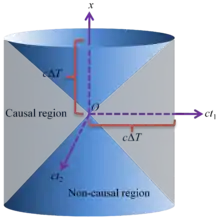Multiple time dimensions
The possibility that there might be more than one dimension of time has occasionally been discussed in physics and philosophy.
Physics
Speculative theories with more than one time dimension have been explored in physics. The additional dimensions may be similar to conventional time, compactified like the additional spatial dimensions in string theory or components of a complex time.
Based on the special orthogonal group SO(10,2), representing the GUT spin group of the extended supersymmetry structure of M-theory, a "two-time physics" has been suggested.[1]
In F-theory the possibility of one or two compactified additional time dimensions is not ruled out.
The existence of a well-posed initial value problem for the ultrahyperbolic equation (a wave equation in more than one time dimension) demonstrates that initial data on a mixed (spacelike and timelike) hypersurface, obeying a particular nonlocal constraint, evolves deterministically in the remaining time dimension.[2]
Like other Complex number variables, complex time is two-dimensional, comprising one real time dimension and one imaginary time dimension, changing time from a real number line into a complex plane. Introducing it into Minkowski spacetime allows a generalization of Kaluza–Klein theory. Complex time has been referred to as "kime" and the modified spacetime model as "space-kime". A suggested advantage of the model is to enable spacetime inference and data-driven analytics based on the extension of longitudinal data (e.g., time-series) to timesurfaces over the 5D spacetime manifold, which is complete and solves many of the problems of time.[3]
Relation to special relativity
Special relativity describes spacetime as a manifold whose metric tensor has a negative eigenvalue. This corresponds to the existence of a "timelike" direction. A modified metric with multiple negative eigenvalues would correspondingly imply a number of such timelike directions, but there is no consensus regarding the possible relationships of these extra "times" to time as conventionally understood.
If the special theory of relativity is generalized for the case of k-dimensional time (t1, t2, ..., tk) and n-dimensional space (xk + 1, xk + 2, ..., xk + n), then the (k + n)-dimensional interval, being invariant, is given by the expression
- (dsk,n)2 = (cdt1)2 + ... + (cdtk)2 − (dxk+1)2 − … − (dxk+n)2.
The metric signature is then
- (timelike sign convention)
or
- (spacelike sign convention).
The transformations between the two inertial frames of reference K and K′, which are in a standard configuration (i.e., transformations without translations and/or rotations of the space axis in the hyperplane of space and/or rotations of the time axis in the hyperplane of time), are given as follows:[4]
where are the vectors of the velocities of K′ against K, defined accordingly in relation to the time dimensions t1, t2, ..., tk; σ = 1, 2, ..., k; λ = k+2, k+3, ..., k+n. Here δσθ is the Kronecker delta. These transformations are generalization of the Lorentz boost in a fixed space direction (xk+1) in the field of the multidimensional time and multidimensional space.

Denoting and where σ = 1, 2, ..., k; η = k+1, k+2, ..., k+n. The velocity-addition formula is then given by
where σ = 1, 2, ..., k; λ = k+2, k+3, ..., k+n.
For simplicity, consider only one spatial dimension x3 and the two time dimensions x1 and x2. (E. g., x1 = ct1, x2 = ct2, x3 = x.) Assuming that in point O, having coordinates x1 = 0, x2 = 0, x3 = 0, there has been an event E. Further assuming that a given interval of time has passed since the event E, the causal region connected to the event E includes the lateral surface of the right circular cone {(x1)2 + (x2)2 − (x3)2 = 0}, the lateral surface of the right circular cylinder {(x1)2 + (x2)2 = c2ΔT2} and the inner region bounded by these surfaces, i.e., the causal region includes all points (x1, x2, x3), for which the conditions
- {(x1)2 + (x2)2 − (x3)2 = 0 and |x3| ≤ cΔT} or
- {(x1)2 + (x2)2 = c2ΔT2 and |x3| ≤ cΔT} or
- {(x1)2 + (x2)2 − (x3)2 > 0 and (x1)2 + (x2)2 < c2ΔT2}
are fulfilled.[4]
Connection to the Planck length and the speed of light
The motion of a test particle in a spacetime with a second time dimension may be described by coordinate
which is the canonical (1,3) spacetime vector with extended by an additional timelike coordinate . is the second time parameter corresponding to , describes the size of the second time dimension and is the characteristic velocity equivalent to . describes the shape of the second time dimension and is a normalization parameter such that is dimensionless.
Decomposing with
and using the metric , the Lagrangian becomes
Applying the Euler-Lagrange Equations
the existence of the Planck length and the constancy of the speed of light can be derived.
As a consequence of this model it has been suggested that the speed of light may not have been constant in the early universe.[5]
Philosophy
Multiple time dimensions appear to allow the breaking or re-ordering of cause-and-effect in the flow of any one dimension of time. This and conceptual difficulties with multiple physical time dimensions have been raised in modern analytic philosophy.[6]
As a solution to the problem of the subjective passage of time, J. W. Dunne proposed an infinite hierarchy of time dimensions, inhabited by a similar hierarchy of levels of consciousness. Dunne suggested that, in the context of a "block" spacetime as modelled by General Relativity, a second dimension of time was needed in order to measure the speed of one's progress along one's own timeline. This in turn required a level of the conscious self existing at the second level of time. But the same arguments then applied to this new level, requiring a third level, and so on in an infinite regress. At the end of the regress was a "superlative general observer" who existed in eternity.[7] He published his theory in relation to precognitive dreams in his 1927 book An Experiment with Time and went on to explore its relevance to contemporary physics in The Serial Universe (1934). His infinite regress was criticised as logically flawed and unnecessary, although writers such as J. B. Priestley acknowledged the possibility of his second time dimension.[8][9]
Literary fiction
Multiple independent timeframes, in which time passes at different rates, have long been a feature of fairy tales.[10] Fantasy writers such as inklings J. R. R. Tolkien and C. S. Lewis have made use of these and other multiple time dimensions, such as those proposed by Dunne, in some of their most famous stories. Tolkien borrowed them for Lórien time in The Lord of the Rings.[10] Lewis adopted them for his Chronicles of Narnia.[11]
References
- Bars, Itzhak. "Two-Time Physics". University of Southern California. Retrieved 8 December 2012.
- Craig, Walter; Weinstein, Steven (2009-07-15). "On determinism and well-posedness in multiple time dimensions". Proceedings of the Royal Society A: Mathematical, Physical and Engineering Sciences. The Royal Society. 465 (2110): 3023–3046. arXiv:0812.0210. Bibcode:2009RSPSA.465.3023C. doi:10.1098/rspa.2009.0097. ISSN 1364-5021.
- Spacekime.org (retrieved 5 January 2020)
- Velev, Milen (2012). "Relativistic mechanics in multiple time dimensions" (PDF). Physics Essays. 25 (3): 403–438. Bibcode:2012PhyEs..25..403V. doi:10.4006/0836-1398-25.3.403.
- Albrecht, Andreas; Magueijo, João (1999-01-28). "Time varying speed of light as a solution to cosmological puzzles". Physical Review D. 59 (4): 043516. arXiv:astro-ph/9811018. Bibcode:1999PhRvD..59d3516A. doi:10.1103/physrevd.59.043516. ISSN 0556-2821.
- Weinstein, Steven. "Many Times". Foundational Questions Institute. Retrieved 5 December 2013.
- McDonald, John Q. (15 November 2006). "John's Book Reviews: An Experiment with Time". Retrieved 8 December 2012.
- J.A. Gunn; The Problem of Time, Unwin, 1929.
- J.B. Priestley, Man and Time, Aldus, 1964.
- Flieger, V.; A Question of Time: JRR Tolkien's Road to Faerie, Kent State University Press, 1997.
- Inchbald, Guy; "The Last Serialist: C.S. Lewis and J.W. Dunne", Mythlore, Issue 137, Vol. 37 No. 2, Spring/Summer 2019, pp. 75-88.
External links
- Bars, Itzhak (2010-11-20). "Gauge Symmetry in Phase Space, Consequences for Physics and Spacetime". International Journal of Modern Physics A. 25 (29): 5235–5252. arXiv:1004.0688. Bibcode:2010IJMPA..25.5235B. doi:10.1142/s0217751x10051128. ISSN 0217-751X.
- Itzhak Bars, John Terning, Extra dimensions in space and time, New York, Springer, Multiversal journeys series, 2010, ISBN 978-0-38777637-8. DOI 10.1007/978-0-387-77638-5.

